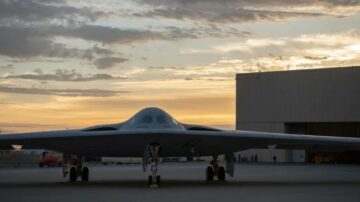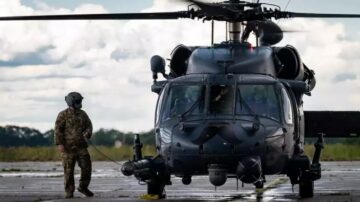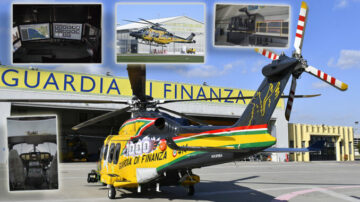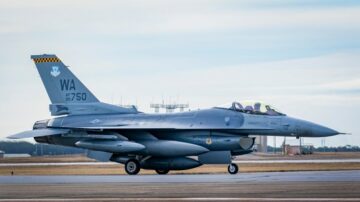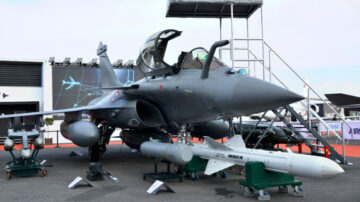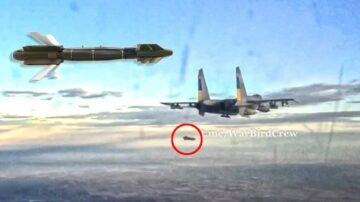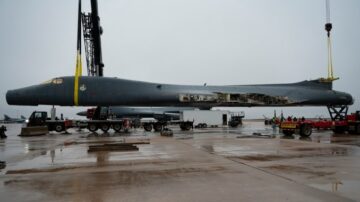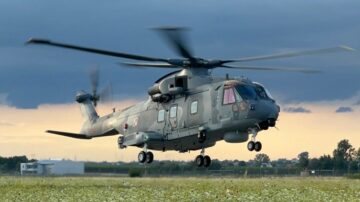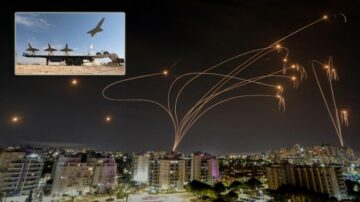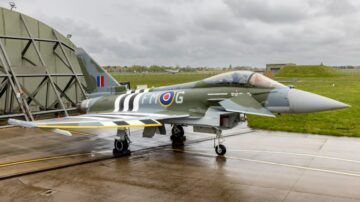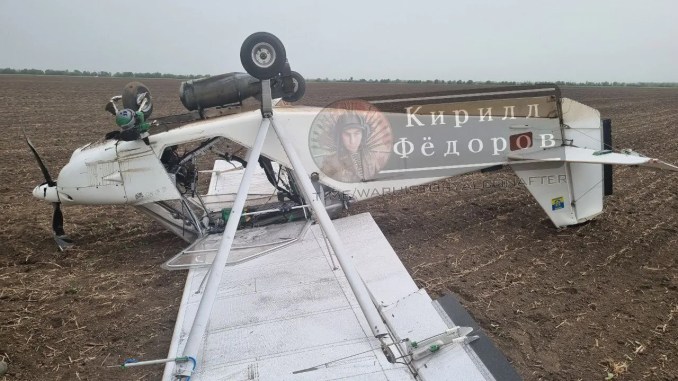
Images shared on social media provide an unprecedented look at one of the light aircraft turned into one-way drones by Ukraine.
On Apr. 26, 2024, images surfaced on Russian social media depicting a light aircraft that had crashed in a field somewhere in Russia. Although someone said it was an A-22 Foxbat, the aircraft in question appears to be a variant of the Ukrainian-manufactured Sky Ranger Nynja, which has been converted into an unmanned aerial vehicle (UAV).
A Ukrainian E-300 enterprise fixed wing long-range UAV crashed in Russia, 1000 km from the border. Russian media write a camera was installed and that it carried a FAB-100 aerial bomb.
Deeper and deeper. pic.twitter.com/aaSHGmP6Gu
— NOELREPORTS 🇪🇺 🇺🇦 (@NOELreports) April 25, 2024
A couple of interesting things are worth a remark: first of all, the UAV was equipped with a single OFAB-100-120 aerial bomb secured to a rail under the fuselage. This bomb, a long-serving Soviet design, weighs 100kg and contains 42kg of explosives.
In addition to the bomb, this UAV features what appears to be a camera or EO/IR turret mounted under the fuselage, possibly used to provide hi-bandwidth live feed to a ground station, or just needed for terminal guidance.
By the way, the designation is not clear: someone say this converted Nynja is called E-300 enterprise while other sources state that the latter is the designation of a variant of the A-22 Foxbat (read below).
HI Sutton , who is investigating Ukrainian long-range kamikaze UAVs, has added a new UAV based on the A-22 aircraft to his infographic following the attack on the Shahed factory in Yelabuz.
The E-300 Enterprise drone has a range of up to 3,100 km and a payload of up to 300 kg.… pic.twitter.com/U8psScBhpT
— TOGA (@TOGAjano21) April 4, 2024
The Sky Ranger Nynja
The Sky Ranger Nynja is a light sport aircraft (LSA) designed and manufactured by the Ukrainian company Aeros Ltd. It is known for its lightweight construction, ease of handling, and versatility. The Nynja is classified as a microlight or ultralight aircraft in many countries due to its low weight and performance characteristics.
One of the standout features of the Sky Ranger Nynja is its modular design, which allows for various configurations and adaptations. It can be used for recreational flying, pilot training, aerial photography, and even as a platform for experimental or specialized applications, such as unmanned aerial vehicle (UAV) conversions.
The Nynja is typically powered by a Rotax 912 series engine, providing adequate power for its size and weight. It boasts a spacious and comfortable cockpit with excellent visibility, making it popular among pilots for leisure flying and training purposes.
As mentioned, the kamikaze drone was mis-identified as an Aeroprakt A-22 Foxbat, another popular light sport aircraft designed and manufactured by Aeroprakt in Ukraine. This type is believed to have been used in the Apr. 4, 2024, when two Ukrainian kamikaze drones were used to carry out two strikes in the Republic of Tatarstan, located more than 1,200 km away from the Ukrainian border. The targets of the strikes were a Shahed-136 drone manufacturing facility and an oil refinery.
The attack represented the first instance of this strategy in the region and the first deployment of such UAVs since the beginning of the conflict.
⚡️1200 km from the border with Ukraine: drones attacked enterprises in Yelabuga and Nizhnekamsk, Tatarstan. A drone arrived at the Elaz-Naftoprodukt Refinery. A second drone arrived in the special economic zone “Alabuga”, where Shahed drones are reportedly assembled. pic.twitter.com/jWFq55pjev
— NOELREPORTS 🇪🇺 🇺🇦 (@NOELreports) April 2, 2024
The making of a long-range kamikaze UAV
Transforming a light aircraft into a long-range kamikaze UAV would involve extensive technical modifications. This process starts with reinforcing the airframe to handle increased payload and fuel, achieved by strengthening the fuselage and wings and removing non-essential components to reduce weight. Enhancements to the propulsion system, including a more powerful engine and additional fuel tanks, would extend the aircraft’s range beyond its original capability.
Upgrades to the control and navigation systems are crucial, allowing remote operation, precise navigation, and real-time data transmission. A dedicated compartment would secure the explosive payload for kamikaze operations, with mechanisms for remote detonation upon reaching the target. Secure communication channels and evasion tactics would be employed to avoid enemy defenses during the mission.
Validation through rigorous testing under simulated conditions is essential to ensure operational effectiveness and safety. This transformation requires interdisciplinary expertise in aerospace engineering, avionics, and military strategy, supported by significant resources and careful planning to achieve operational readiness discreetly.
- SEO Powered Content & PR Distribution. Get Amplified Today.
- PlatoData.Network Vertical Generative Ai. Empower Yourself. Access Here.
- PlatoAiStream. Web3 Intelligence. Knowledge Amplified. Access Here.
- PlatoESG. Carbon, CleanTech, Energy, Environment, Solar, Waste Management. Access Here.
- PlatoHealth. Biotech and Clinical Trials Intelligence. Access Here.
- Source: https://theaviationist.com/2024/04/26/close-look-at-ukr-kamikaze-drone/?utm_source=rss&utm_medium=rss&utm_campaign=close-look-at-ukr-kamikaze-drone
- :has
- :is
- :not
- :where
- $UP
- 1
- 100
- 125
- 1996
- 2%
- 200
- 2024
- 25
- 26
- 2nd
- 300
- 4
- a
- Achieve
- achieved
- Adaptations
- added
- addition
- Additional
- adequate
- aerial vehicle
- Aerospace
- aerospace engineering
- AIR
- Air Force
- aircraft
- All
- Allowing
- allows
- Although
- among
- an
- and
- Another
- appears
- applications
- apr
- ARE
- arrived
- AS
- assembled
- At
- attack
- attacked
- Australia
- avatar
- aviation
- avoid
- away
- based
- BE
- been
- Beginning
- believed
- below
- Beyond
- blogs
- boasts
- bomb
- Books
- border
- by
- called
- camera
- CAN
- capability
- careful
- carried
- carry
- channels
- characteristics
- classified
- clear
- Close
- Cockpit
- combat
- comfortable
- Communication
- company
- components
- computer
- Computer Engineering
- conditions
- configurations
- conflict
- construction
- contains
- contributed
- control
- conversions
- converted
- countries
- Couple
- covering
- Crashed
- credit
- Crime
- crucial
- data
- David
- dedicated
- deeper
- Defense
- defenses
- depicting
- deployment
- Design
- designation
- designed
- different
- drone
- Drones
- due
- during
- ease
- Economic
- editor
- effectiveness
- employed
- Engine
- Engineering
- enhancements
- ensure
- Enterprise
- enterprises
- equipped
- essential
- Europe
- evasion
- Even
- excellent
- experimental
- expertise
- extend
- extensive
- Facility
- factory
- famous
- Features
- field
- First
- first close
- five
- fixed
- flying
- following
- For
- Force
- Forces
- Former
- founder
- from
- Fuel
- graduate
- Ground
- guidance
- had
- handle
- Handling
- Have
- he
- here
- his
- HTML
- http
- HTTPS
- image
- images
- in
- Including
- increased
- industry
- infographic
- installed
- instance
- Intelligence
- interesting
- into
- investigating
- involve
- IT
- Italian
- Italy
- ITS
- journalist
- jpeg
- just
- known
- latter
- light
- lightweight
- live
- located
- Look
- Low
- Ltd
- magazines
- major
- Making
- manufactured
- manufacturing
- many
- mechanisms
- Media
- mentioned
- Military
- Mission
- Modifications
- modular
- monthly
- more
- most
- Navigation
- needed
- New
- of
- Oil
- on
- ONE
- ones
- operation
- operational
- Operations
- or
- original
- Other
- Others
- our
- out
- performance
- photo
- photography
- pilot
- Pilots
- Planes
- planning
- platform
- plato
- Plato Data Intelligence
- PlatoData
- Popular
- possibly
- power
- powered
- powerful
- precise
- private
- process
- propulsion
- provide
- providing
- purposes
- question
- Rail
- range
- reaching
- Read
- Readiness
- real-time
- real-time data
- Recreational
- reduce
- region
- remote
- removing
- Reported
- reportedly
- represented
- Republic
- requires
- Resources
- rigorous
- rome
- Russia
- russian
- s
- Safety
- Said
- say
- Second
- secure
- Secured
- Series
- several
- shared
- significant
- since
- single
- Size
- sky
- Social
- social media
- Someone
- somewhere
- Sources
- soviet
- special
- specialized
- Sport
- standout
- starts
- State
- station
- Strategy
- strengthening
- Strikes
- such
- Supported
- Syria
- system
- Systems
- tactics
- Tanks
- Target
- targets
- tatarstan
- Technical
- Terminal
- Testing
- than
- that
- The
- things
- this
- Through
- to
- Training
- Transformation
- transmission
- Turned
- two
- type
- typically
- u.s.
- UAV
- Ukraine
- Ukrainian
- under
- unprecedented
- upon
- used
- Variant
- various
- vehicle
- versatility
- via
- visibility
- war
- was
- Way..
- weighs
- weight
- were
- What
- which
- while
- WHO
- Wing
- wings
- with
- world’s
- worldwide
- worth
- would
- write
- written
- X
- zephyrnet
- zone


